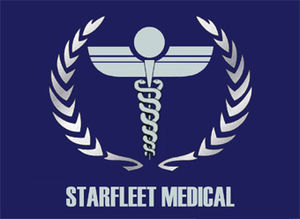Starfleet Combat Medicine Manual: Difference between revisions
Kane Morgan (talk | contribs) |
Kane Morgan (talk | contribs) m (→PERTINENT INFO) |
||
| Line 22: | Line 22: | ||
When communicating with Starfleet medical control, a medical officer or a receiving facility, a verbal report will include the following essential elements: | When communicating with Starfleet medical control, a medical officer or a receiving facility, a verbal report will include the following essential elements: | ||
==PERTINENT INFO== | ===PERTINENT INFO=== | ||
1. Provider – name, and unit. | 1. Provider – name, and unit. | ||
Revision as of 08:26, 12 January 2012
Historically in warfare, the majority of all combat deaths have occurred prior to a casualty ever receiving advanced trauma management.
Aboard a ship, starbase, or planet-side colony, StarFleet Medical personnel provide day-to-day medical care, and treat injuries just like any other doctor. Their main responsibility is the physical well being and health of the crew and civilians on board their ship or base. They are also responsible for low-level sickness care. In crisis situations, this quickly changes and expands anywhere from low-level injury care to high-level surgery.
The Chief Medical Officer (CMO) co-ordinates the efficient running of the Medical department and is responsible for the activities of the personnel therein. It is the CMO's job to ensure that the medical personnel are organized to ensure maximum productivity and also provide maximum medical and emergency response cover for the ship.
MEDICAL OFFICER
A trained and credentialed medical provider, physician or physician assistant, who verbally, or in writing, states assumption of responsibility and liability and is available on-site or can be contacted through established communications. Medical care, procedures, and advanced life-saving activities will be routed through medical control in order to provide optimal care to all sick or injured Starfleet personnel. Medical Control will always be established, regardless of whether the scenario is a combat mission, a training exercise, or routine medical care. Note that, ultimately, all medical care is conducted under the licensure of an assigned, attached, augmenting, or collocated Starfleet physician.
STANDING ORDERS AND PROTOCOLS
These standing orders and protocols are only to be used by Starfleet Medical Officers and Teams.
PURPOSE
The primary purpose of these protocols is to serve as a guideline for tactical and non-tactical pre-hospital trauma and medical care. Quality out-of-hospital care is the direct result of comprehensive education, accurate patient assessment, good judgment, and continuous quality improvement. All Starfleet medical personnel are expected to know the Trauma Management Team Protocols and understand the reasoning behind their employment. Starfleet Doctors should not perform any step in a standing order or protocol if they have not been trained to perform the procedure or treatment in question. Emergency, trauma, and tactical medicine continues to evolve at a rapid pace. Accordingly, this document is subject to change as new information and guidelines become available and are accepted by the medical community.
COMMUNICATIONS
In a case where the Starfleet Doctor cannot contact Medical Control due to an acute time-sensitive injury or illness, a mass casualty scenario, or communication difficulties, all protocols become standing orders. Likewise, in the event that Starfleet Medical Control cannot respond to comm-badge instructions in a timely fashion required to provide optimal care to a patient, all protocols are considered standing orders. In the event that Starfleet Medical Control was not contacted, and treatment protocols were carried out as standing orders, Starfleet Medical Control will be contacted as soon as feasible following the incident and the medical record will be reviewed and countersigned by Starfleet Medical Control. Retroactive approval for appropriate care will be provided through this process.
When communicating with Starfleet medical control, a medical officer or a receiving facility, a verbal report will include the following essential elements:
PERTINENT INFO
1. Provider – name, and unit.
2. Patient – name, unit, age, and gender.
3. Subjective – findings to include chief complaint and brief history of event.
4. Objective – findings to include mental status, vital signs, and physical exam.
5. Assessment – to include differential diagnosis and level of urgency.
6. Plan – to include treatment provided, patient response to treatment, and ETA.
Provide patient status updates as dictated by patient status changes en route.
PATIENT CARE DOCUMENTATION
Patient care documentation is of paramount importance and should be performed for every patient encounter using a SMA Combat Casualty Card, a Trauma SF 600 Medical Record, or a SF 600 Medical Record.
THE 8 “CRITICAL” Combat Medicine TASKS:
1) Contain Scene and Assess Casualties.
Return Fire and Secure Scene. Direct Casualties to Cover. Evaluate for Life Threatening Injuries. Triage – Immediate, Delayed, Minimal, Expectant. Call Medical Personnel for Assistance as Required.
2) Rapidly Identify and Control Massive Hemorrhage.
Direct & Indirect Pressure. Tourniquet. Emergency Trauma Dressing.
3) Inspect and Ensure Patent Airway.
Open and Clear Airway. Nasopharyngeal Airway.
4) Treat Life Threatening Torso Injuries.
Occlusive Seal Dressing. Needle Decompression. Abdominal wound management.
5) Inspect for Bleeding, Gain IV Access, Manage Shock.
Head to Toe Blood Sweeps. 18 Gauge Saline Lock. IV Fluids when dictated by Shock. Prevent Hypothermia.
6) Control Pain and Prevent Infection.
Combat Wound Pill Pack.
7) Aid and Litter Team.
Package and Prepare for Transfer. MEDCO, Litters, Manual Carries.
8) Leader Coordinated Evacuation.
Casualty Precedence – Critical (Urgent), Priority, Routine. MEDEVAC Coordination.
